
OSHA Handrail Project Guide
Fitting Specification & Usage

How does a Kee Klamp Fitting Work?
The concept is very straightforward. Using an allen key, a hardened set screw with a sharpened edge is tightened down so that it bites into the pipe inserted into the fitting. The resulting connection is extremely strong and is a suitable substitute for a welded connection in railing scenarios.
Is it Really Strong Enough?
Technically speaking the connection inside of a Kee Klamp Fitting can support an axial load of 2000 lbs. per set screw when the set screw is tightened to a torque of 29 lbs./ft. However, the proof you are looking for can be found in the thousands of railing configurations that have been constructed all over the United States and Europe. Railings built with Kee Klamp fittings have stood the test of time and "the elements". If you're looking for more read our Should You Weld section.
What Tools Are Required?
The fittings themselves require one simple tool: an allen wrench.
Additionally, you will need a way of mounting the upright into the ground. See the ground fixing section for more information.
Ground Fixing Choices

Type 62 - Standard Railing Base
Ideal fitting for fixing handrail uprights on a level surface. Two set screws securely hold the upright in place and give great side load stability. There are two large holes in the base to allow the flange to be connected to the surface with a mechanical or chemical anchor.

Type 64, 65, 68, L164 - Vertical Railing Base
This fitting is used when the railing base needs to be offset from the side of a structure or walkway. The different hole configurations (vertical, horizontal and 4 hole) are available to suit the various requirements of offset handrail installations.

Type 66 - Concrete Fixing
A ground socket fitting for setting in concrete; the posts may either be permanent or removable as required. It incorporates a socket set screw fixing and can be supplied with a plug to fill the hole when the pipe is removed. Also used for ADA compliant railing.

Type 67 - 3° to 11° Angle Base Flange
This fitting is suitable when installing handrail uprights on a ramp. When placed on a 3° to 11° surface, this fitting allows the railing post to be plumb to the ground.

Type 69 - Rail Flange with Toe board Adapter
The Type 69 fitting has been designed for guard railing and handrail upright applications and provides the added benefit of attaching a toe board to the base. The base plate holes are of sufficient diameter to allow for attachment with either a mechanical or chemical anchor, the side plates have slotted holes to allow for a degree of sideways movement for ease of installation. See the Toe board section for more details.
Toeboards

When is Toe board Required
OSHA standards require four (4) inch toe board when beneath the open sides of a railing (1) a person can pass, (2) there is moving machinery, or (3) there is equipment with which falling materials could create a hazard. [ref. 1910.23(e)(4)]
How do I attach the Toe board to the Railing
There are two ways that you can attach toe board to a Kee Klamp failing. (1) The first way is to use the toe board ground fixing pictured above. It is available in aluminum and steel. (2) The second way is to use some u-bolt hardware that connects the toe board directly to the pipe.
Pipe Choices

Galvanized Steel
Schedule 40 and Schedule 80; size 1/4" to 2" IPS; nominal mill lengths of 21' cut to your projects' exact length requirements.
Aluminum
Alloy 6105-T5 with an anodized finish; size range 3/4" to 2" IPS; nominal mill lengths of 12' and 24' cut to your projects' exact length requirements
Powder Coating
Durable, corrosion preventing polyester coating applied to already galvanized/anodized products; available in any RAL color
Antimicrobial Coating
Defense against the growth of potentially harmful invisible bacteria and fungi; this powder coating can be applied in a wide range of RAL colors
OSHA and ADA Handrail Standards
ADA Handrail Standards
We have an entire section of our web site devoted to ADA handrail standards. Visit the ADA Handrail Guide for more information.
OSHA Handrail Standards
Here are some basic pieces of information to bear in mind when constructing a handrail to comply with OSHA Standards.
- The top rail of the handrail must be a minimum of 42" [ref. 1910.23(e)(1)]
- The intermediate (middle) rail should be located in the middle of the upright creating equal space between the floor and the top rail. [ref. 1910.23(e)(1)]
- The pipe used in the construction of the railing should be at least 1 1/2" nom. bore schedule 40 pipe. [ref. 1910.23(e)(ii)]
- The railing should be able to withstand up to 200 lbs. of force applied in any direction to the top rail. [ref. 1910.23(e)(3)(iv)]. This is accomplished by properly using any of the standard handrail fixings mentioned in this guide.
- When is toe board required? Four (4) inch toe board is required when beneath the open sides (1) a person can pass, (2) there is moving machinery, or (3) there is equipment with which falling materials could create a hazard. [ref. 1910.23(e)(4)]
In-Fill Panels

Various Infill Panel Styles
Material can be provided with a galvanized or powder coat finish, or in bare stainless steel. Virtually any custom configuration or material option is available. Talk to a Fall Protection Specialist for more information.
Ready to Get a
Quote on OSHA Compliant Guardrail?
